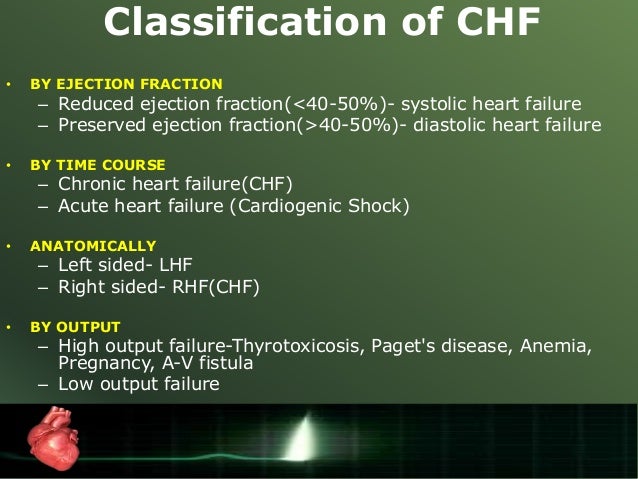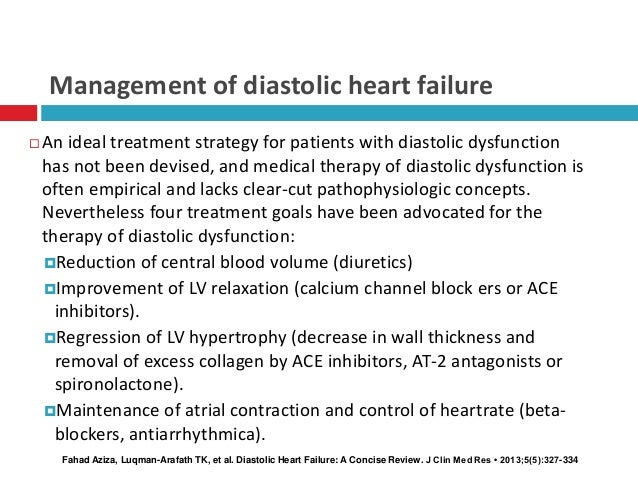Drugs used in chronic heart failure
Drugs used in chronic heart failure






Outpatient Treatment of Systolic Heart Failure
Optimal outpatient treatment of systolic heart failure has three goals that should be pursued simultaneously: (1) control of risk factors for the development and progression of heart failure, (2) treatment of heart failure, and (3) education of patients. Control of risk factors includes treating hypertension, diabetes, and coronary artery disease, and eliminating the use of alcohol and tobacco. All patients with heart failure should be taking an angiotensin-converting enzyme (ACE) inhibitor or angiotensin-receptor blocker. In the absence of contraindications, an ACE inhibitor is preferred. In most patients, physicians should consider adding a beta blocker to ACE-inhibitor therapy. In patients with severe heart failure, spironolactone is a useful addition to baseline drug therapy, as is carvedilol (substitute carvedilol if patient is already taking a beta blocker). Patients with stable heart failure should be encouraged to begin and maintain a regular aerobic exercise program. Digoxin therapy may reduce the likelihood of hospitalization but does not reduce mortality. It must be monitored closely, with a target dosage level of 0.5 to 1.1 ng per mL. Symptoms may be controlled with the use of diuretics and restricted dietary sodium. Finally, patient education, with the patient’s active participation in the care, is a key strategy in the management of heart failure. Periodic follow-up between scheduled office visits, which is essential in the long-term management of heart failure, may include telephone calls from the office nurse, maintenance of a daily symptom and weight diary, and participation in a disease-management program.
Strength of Recommendation
| KEY CLINICAL RECOMMENDATIONS | LABEL | REFERENCES |
|---|---|---|
Angiotensin-converting enzyme (ACE) inhibitors should be the initial baseline treatment in all patients with heart failure, if tolerated, regardless of New York Heart Association (NYHA) class.
|
A
| |
Angiotensin-receptor blockers have benefits similar to those of ACE inhibitors and are useful in patients who cannot tolerate ACE inhibitors.
|
A
| |
Aerobic exercise is recommended because it decreases the number of hospitalizations and improves quality of life.
|
A
| |
Comprehensive, multidisciplinary outpatient follow-up is recommended because it decreases the rate of hospitalization for heart failure.
|
A
| |
Beta blockers are recommended for most patients with heart failure; they also may be useful if there are concomitant tachydysrhythmias following myocardial infarction.
|
A
| |
Carvedilol reduces mortality in patients with severe heart failure (i.e., NYHA classes III or IV).
|
A
| |
Spironolactone reduces mortality in patients with severe heart failure (i.e., NYHA classes III or IV); patients must be monitored closely for hyperkalemia.
|
A
| |
Eplerenone reduces mortality in patients with left ventricular dysfunction following myocardial infarction.
|
A
| |
Hydralazine plus isosorbide dinitrate is beneficial, but its use is limited by poor tolerability.
|
A
| |
Digoxin is an option that may reduce the number of hospitalizations but does not reduce the rate of mortality.
|
B
| |
Diuretics are useful for fluid, sodium, and symptom control.
|
B
| |
Dietary sodium restriction is recommended, but studies have not measured patient-oriented outcomes.
|
C
|
A = consistent, good-quality patient-oriented evidence; B = inconsistent or limited-quality patient-oriented evidence; C = consensus, disease-oriented evidence, usual practice, opinion, or case series. See page 2055 for more information.
TABLE 2
Dosing of Recommended Medications in the Treatment of Systolic Heart Failure
| DRUG | INITIAL DOSAGE | TARGET DOSAGE | COMMENTS | |
|---|---|---|---|---|
ACE inhibitors
| ||||
Captopril (Capoten)
|
6.25 to 12.5 mg three times daily
|
50 to 100 mg three times daily
|
For all ACE inhibitors, start at 50 percent of the initial ACE-inhibitor dosage in patients who have renal insufficiency or are taking moderate to high dosages of diuretics.FDA-approved for heart failure following myocardial infarction
| |
Enalapril (Vasotec)
|
5 mg once or twice daily
|
10 to 20 mg twice daily
| ||
Fosinopril (Monopril)
|
10 mg once daily
|
20 to 40 mg once daily
| ||
Lisinopril (Zestril)
|
2.5 to 10 mg once daily
|
20 mg once daily
| ||
Ramipril (Altace)
|
2.5 mg once daily
|
5 mg twice daily
| ||
Trandolapril (Mavik)
|
1 mg once daily
|
4 mg once daily
| ||
Beta blockers
| ||||
Bisoprolol (Zebeta)
|
1.25 mg once daily
|
10 mg once daily
|
Not FDA-approved for heart failure
| |
Carvedilol (Coreg)
|
3.125 mg twice daily
|
25 mg twice daily (50 mg if patient’s weight is > 85 kg [187 lb])
|
For all beta blockers, increase dosage every two weeks.
| |
Metoprolol (Toprol XL)
|
25 mg once daily (12.5 mg once daily in patients with severe heart failure)
|
200 mg once daily
| ||
Metoprolol, immediate release (Lopressor)
|
12.5 to 25 mg twice daily (lower dosages in patients with severe heart failure)
|
100 mg twice daily
|
Not FDA-approved for heart failure
| |
Other medications
| ||||
Digoxin
|
0.125 to 0.25 mg once daily
|
Dose to a target serum digoxin concentration of 0.5 to 1.1 ng per mL.
|
Start at the lower dosage in patients with mild renal insufficiency.
| |
Spironolactone (Aldactone)
|
25 mg once daily
|
25 to 50 mg every other day or every day
|
Not FDA-approved for heart failure
| |
ACE = angiotensin-converting enzyme; FDA = U.S. Food and Drug Administration. Information from reference 31.


TABLE 3
Converting Patients to Carvedilol from Beta-Blocker Therapy
| BETA-BLOCKER DOSAGE | CARVEDILOL DOSAGE | |
|---|---|---|
No overlap method
| ||
Not currently receiving a beta blocker
|
Start carvedilol in a dosage of 3.125 mg twice daily; titrate dosage every one to two weeks to the maximum tolerated dosage or 25 mg twice daily.
| |
Metoprolol (Toprol XL), 50 mg per day, or atenolol (Tenormin), 50 mg per day
|
Start carvedilol in a dosage of 6.25 mg twice daily; titrate dosage every one to two weeks.
| |
Overlap method
| ||
Atenolol, 200 mg per day
|
Add carvedilol in a dosage of 3.125 mg twice daily for two weeks, then reduce dosage of atenolol to 150 mg daily for two weeks, then double the carvedilol dosage every two weeks while reducing the daily dosage of atenolol by 50 mg.
| |
When dosage of atenolol reaches 50 mg, decrease dosage to 25 mg daily for two weeks and discontinue.
| ||
Atenolol, 50 to 150 mg per day
|
Add carvedilol in a dosage of 3.125 mg twice daily for two weeks, then double the carvedilol dosage every two weeks while reducing the atenolol dosage by 50 mg.
| |
When atenolol reaches 50 mg, decrease to 25 mg daily for two weeks and discontinue.
| ||
Metoprolol, 100 to 200 mg per day
|
Add carvedilol in a dosage of 3.125 mg twice daily for two weeks, then double the carvedilol dosage every two weeks while reducing the daily metoprolol dosage by 50 mg.
| |
Discontinue metoprolol after two weeks of 50 mg per day.
| ||



Comments
Post a Comment